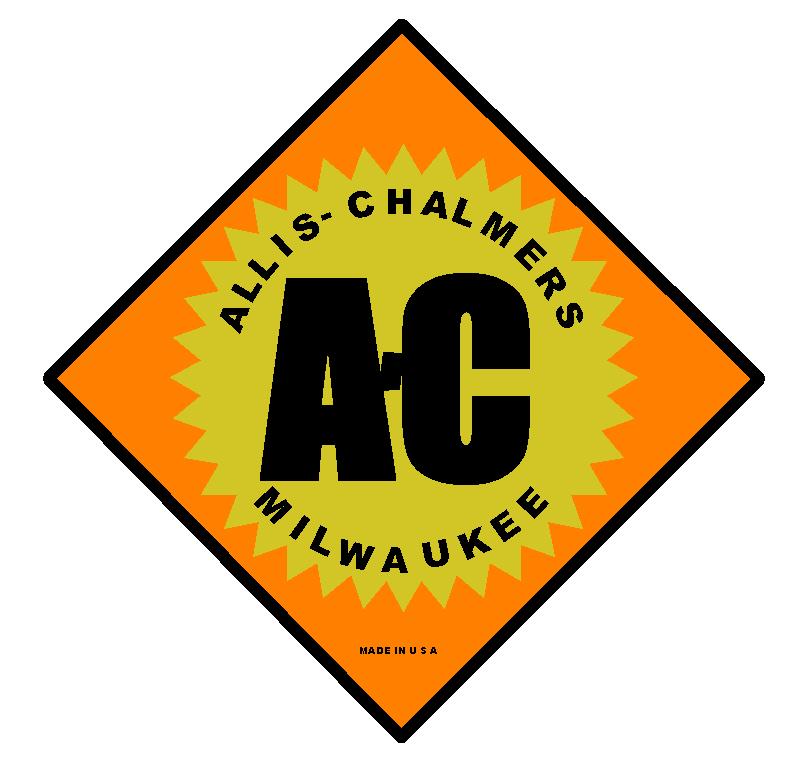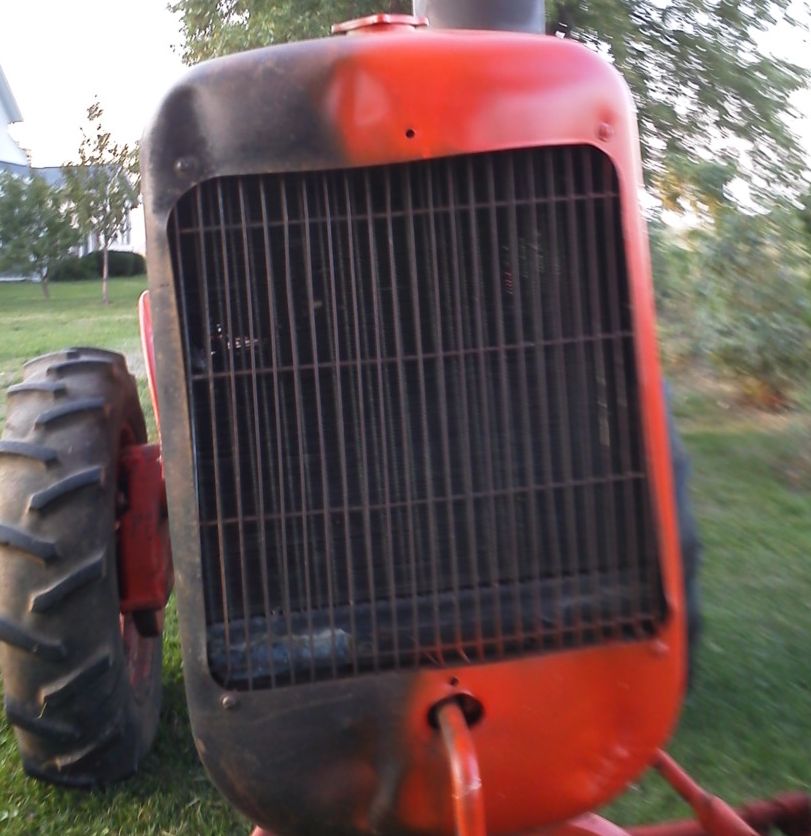| Author |
 Topic Search Topic Search  Topic Options Topic Options
|
briwayjones 
Bronze Level

Joined: 09 May 2010
Location: Sykesville, MD
Points: 75
|
 Post Options Post Options
 Thanks(0) Thanks(0)
 Quote Quote  Reply Reply
 Topic: :Model B, C 12volt conversion, how many amps? Topic: :Model B, C 12volt conversion, how many amps?
Posted: 20 Sep 2012 at 11:34pm |
|
On a Model B, C converted to a 12 volt system how many charging amps are needed?
|
 |
|
Sponsored Links
|
|
 |
briwayjones 
Bronze Level

Joined: 09 May 2010
Location: Sykesville, MD
Points: 75
|
 Post Options Post Options
 Thanks(0) Thanks(0)
 Quote Quote  Reply Reply
 Posted: 20 Sep 2012 at 11:46pm Posted: 20 Sep 2012 at 11:46pm |
|
I'm asking because it seems that everybody that does a 12 volt conversion uses an alternator. If you wanted to do a 12 volt conversion but still wanted the tractor to look mostly factory couldn't you use a 12 volt generator from a AC D15?
|
 |
Gerald J. 
Orange Level

Joined: 12 Sep 2009
Location: Hamilton Co, IA
Points: 5636
|
 Post Options Post Options
 Thanks(0) Thanks(0)
 Quote Quote  Reply Reply
 Posted: 21 Sep 2012 at 12:29am Posted: 21 Sep 2012 at 12:29am |
|
Depends on the auxiliaries and how long you intend to run it each time you start it. Applying 12 volts to the 6 volt starter is going to increase the cranking amps some.
Most use an alternator because it comes with a solid state regulator that treats batteries right while the older vibrating magnetic regulators didn't always do so well. Their precision of voltage regulation was generally poorer tending to cause poorer battery performance if low and poorer battery life if high. In the 60s SAE standards allowed a regulator to be acceptable from 13 to 15 volts. While a 12 volt battery capacity is seriously reduced if only charged to 13 volts and battery life is cut seriously if constantly charged to 15 volts. The overcharging makes the battery lose water and then if not regularly refilled, it looses plate area and capacity as if it was undercharged.
A solid state regulator (and I've built a couple) for a generator can make it work as good as an alternator. First one was when I put a 1500 CC VW engine in a '64 bug that was 6 volts. The generators and generator mounts wouldn't interchange so I built a 6 volt regulator for the 12 volt generator and it charged at low engine speeds like an alternator. I also used a diode for the cutout so there wasn't the reverse current of the magnetic regulator and cutout at low engine speeds which improved the charging efficiency at low engine speeds. But there are few solid state regulators on the market for a generator though Steve offers solid state (e.g. diode) cutouts. And new magnetic regulators tend to be set even poorer than SAE standards used to allow. My first farm size tractor came with a nearly new regulator, but didn't charge like it should. I took the cover off and adjusted (by bending a part) it for proper charging voltage and that tractor gets a good battery life even though the generator only charges at 20 amps maximum. So long as I run it long enough to get the battery current tapered down towards zero and its been 22 years since I made that adjustment. A 60 amp alternator would charge three times as fast if the wiring was sturdy enough. I help that tractor with a battery maintainer after running the tractor. That tractor drives the tachometer off a gear box on the back of the generator making an alternator a difficult replacement.
Then today more people know an alternator than a generator.
For certain the correct police would prefer a generator to an alternator on a vintage tractor. But on my 4020 when i found the regulator bad after replacing a worn out pulley and adding an ammeter, I bought an alternator for just a few bucks more than a JD regulator and get much improved battery life. Changing the battery away from JD's long skinny battery also helped battery life and cost.
For that matter the correct police would prefer it was left 6 volts, after all, it has started for more than 50 years on 6 volts, maybe more than 70 years, so long as the battery cable connections get cleaned more than once a year.
Gerald J.
Edited by Gerald J. - 21 Sep 2012 at 12:38am
|
 |
Gary 
Orange Level Access

Joined: 13 Sep 2009
Location: Peterborough,On
Points: 5902
|
 Post Options Post Options
 Thanks(0) Thanks(0)
 Quote Quote  Reply Reply
 Posted: 21 Sep 2012 at 7:43am Posted: 21 Sep 2012 at 7:43am |
Here is a link to Dewey Shutter website for a wiring diagram 6V to 12V. Gary
|
 |
EdK 
Silver Level


Joined: 12 Sep 2009
Location: Newcastle, CA
Points: 223
|
 Post Options Post Options
 Thanks(0) Thanks(0)
 Quote Quote  Reply Reply
 Posted: 21 Sep 2012 at 8:58am Posted: 21 Sep 2012 at 8:58am |
|
Since you are striving for a politically correct look, I assume the B/C is still a magneto sparker. In that case all the generator does is charge the battery after the starter discharge. There is no high current required to do this so I assume just about any auto generator will do the job.
|
 |
Gerald J. 
Orange Level

Joined: 12 Sep 2009
Location: Hamilton Co, IA
Points: 5636
|
 Post Options Post Options
 Thanks(0) Thanks(0)
 Quote Quote  Reply Reply
 Posted: 21 Sep 2012 at 9:57am Posted: 21 Sep 2012 at 9:57am |
|
Sometimes cranking a magneto B/C with 12 volts makes it start poorly, because it cranks too fast for the impulse mechanism in the magneto. But not fast enough for good spark without the impulse.
Gerald J.
|
 |
briwayjones 
Bronze Level

Joined: 09 May 2010
Location: Sykesville, MD
Points: 75
|
 Post Options Post Options
 Thanks(0) Thanks(0)
 Quote Quote  Reply Reply
 Posted: 21 Sep 2012 at 7:28pm Posted: 21 Sep 2012 at 7:28pm |
 EdK wrote: EdK wrote:
Since you are striving for a politically correct look, I assume the B/C is still a magneto sparker. In that case all the generator does is charge the battery after the starter discharge. There is no high current required to do this so I assume just about any auto generator will do the job. |
No actually it's been converted to a distributor.
|
 |
dave63 
Orange Level


Joined: 01 Feb 2011
Location: Lineboro Md
Points: 2382
|
 Post Options Post Options
 Thanks(0) Thanks(0)
 Quote Quote  Reply Reply
 Posted: 21 Sep 2012 at 7:47pm Posted: 21 Sep 2012 at 7:47pm |
The original B generator can be set for its max. volt output and will be pleanty to keep 12 volt battery charged.
Bin there done that.
|
|
The universal answer to all questions is yes, how much do you want to spend?
|
 |
dave63 
Orange Level


Joined: 01 Feb 2011
Location: Lineboro Md
Points: 2382
|
 Post Options Post Options
 Thanks(0) Thanks(0)
 Quote Quote  Reply Reply
 Posted: 21 Sep 2012 at 7:51pm Posted: 21 Sep 2012 at 7:51pm |
BTW you will need a resister to cut the coil voltage back and 12 v light bulbs.
The 6 v starter will work great.
My IB has 12 volt battery with generator and the regulator has been sticking. And i have had a little over charge going on.
|
|
The universal answer to all questions is yes, how much do you want to spend?
|
 |
briwayjones 
Bronze Level

Joined: 09 May 2010
Location: Sykesville, MD
Points: 75
|
 Post Options Post Options
 Thanks(0) Thanks(0)
 Quote Quote  Reply Reply
 Posted: 21 Sep 2012 at 8:45pm Posted: 21 Sep 2012 at 8:45pm |
|
How do you set the generator to it's max so it'll charge a 12v battery? As far as lights, it hasn't had any lights on it since before we got it. So at this point that's not a concern. So the resistor would go before the coil? What kind of resistor, and how do you install it? I have done some wiring on various things and some soldering. Is installing the resistor something I could do fine?
Would it just be better to get a 12v coil? How much do coils run?
Edited by briwayjones - 21 Sep 2012 at 8:53pm
|
 |
dave63 
Orange Level


Joined: 01 Feb 2011
Location: Lineboro Md
Points: 2382
|
 Post Options Post Options
 Thanks(0) Thanks(0)
 Quote Quote  Reply Reply
 Posted: 21 Sep 2012 at 9:06pm Posted: 21 Sep 2012 at 9:06pm |
|
sent PM
|
|
The universal answer to all questions is yes, how much do you want to spend?
|
 |
DaveKamp 
Orange Level Access


Joined: 12 Apr 2010
Location: LeClaire, Ia
Points: 6081
|
 Post Options Post Options
 Thanks(0) Thanks(0)
 Quote Quote  Reply Reply
 Posted: 22 Sep 2012 at 9:15am Posted: 22 Sep 2012 at 9:15am |
|
If you REALLY want the down-and-dirty, you can do a web-search for Delco-Remy Regulator, there's several good sites out there that have some pretty extensive original setup documentation in a downloadable format.
The regulator consists of either two or three mechanical components. First is a cutout... it's an electromagnet relay that disconnects the regulator and alternator field anytime the generator is not spinning above a generating speed. This prevents the battery from being drained.
The second, is the charging control electromagnet. It limits upper voltage by opening up the generator's field winding anytime voltage gets high enough to pull in the electromagnet's armature. The armature is held closed by a spring, which on many regulators, is held on one end by an adjustable base... a small phillips screw provides adjustment of the spring's preload, hence, voltage. Increase tension, and the 'voltage window' goes up... because it takes more output voltage to 'pull in' the armature (and disconnect the field'.
In a 'pure' sense, what happens, is when voltage rises above the armature's setpoint, the contacts open. In an operational sense, the contacts open only for a moment... because once they do, the generator's field falls, so output voltage of the generator falls... as a result, the regulator's contacts become a buzzer... they vibrate, and the amount of off time, vs. on-time, determine how much current flows through the field, and the end result, is regulated output voltage.... essentially... more or less...
The third element isn't often found in tractors that I've seen, but not an uncommon bird... it's a 'current limiter'... another electromagnet coil that cuts off the alternator anytime output current exceeds a certain limit. It protects the alternator against a dead short on the output.
|
|
Ten Amendments, Ten Commandments, and one Golden Rule solve most every problem. Citrus hand-cleaner with Pumice does the rest.
|
 |
steve(ill) 
Orange Level Access


Joined: 11 Sep 2009
Location: illinois
Points: 88219
|
 Post Options Post Options
 Thanks(0) Thanks(0)
 Quote Quote  Reply Reply
 Posted: 22 Sep 2012 at 9:23am Posted: 22 Sep 2012 at 9:23am |
|
a 6 volt generator will put out about 14 volts when not connected to the battery. A 12 volt generator will put out about 30 volts when not connected to a battery.. So Yes, you can use the 6 volt generator to charge a 12 volt battery. Best to use a 12 volt regulator n the system. Possibly not the best solution, but it will work. ... ALso you should use a new 12 volt coil. THe resistor with the old 6 volt coil will eventually cause problems.
|
|
Like them all, but love the "B"s.
|
 |
Coke-in-MN 
Orange Level Access


Joined: 12 Sep 2009
Location: Afton MN
Points: 42010
|
 Post Options Post Options
 Thanks(0) Thanks(0)
 Quote Quote  Reply Reply
 Posted: 22 Sep 2012 at 9:58am Posted: 22 Sep 2012 at 9:58am |
Just about everything you need to know on Delco .
http://chevy.oldcarmanualproject.com/electrical/49dr324/index.htm
Some info on Alt
|
|
Life lesson: If you’re being chased by a lion, you’re on a horse, to the left of you is a giraffe and on the right is a unicorn, what do you do? You stop drinking and get off the carousel.
|
 |
allischalmerguy 
Orange Level


Joined: 11 Sep 2009
Location: Deep River, IA
Points: 2893
|
 Post Options Post Options
 Thanks(0) Thanks(0)
 Quote Quote  Reply Reply
 Posted: 22 Sep 2012 at 3:28pm Posted: 22 Sep 2012 at 3:28pm |
|
Man this is neat stuff, I wish I could absorb it all!
|
|
It is great being a disciple of Jesus! 1950 WD, 1957 D17...retired in Iowa,
|
 |
GregLawlerMinn 
Orange Level


Joined: 11 Sep 2009
Location: Lawler, Mn
Points: 1226
|
 Post Options Post Options
 Thanks(0) Thanks(0)
 Quote Quote  Reply Reply
 Posted: 22 Sep 2012 at 4:16pm Posted: 22 Sep 2012 at 4:16pm |
Needed charging amps depends on how much is drawn out of the battery when starting, how much draw is needed when operating, and how long the tractor is operated. Most tractor usage is such that batteries are not drawn down much, esp when they are dialed in and start right up...and the only draw when running is the ignition, and sometimes, lights. In fact, I have run the tractors with no gennie/alternator by charging the battery with a charger every several days. I have converted several CA's to 12V neg grd and have used the short 12V generator from the older GMs (Chevys...they bolt right into the 6V mounting bracket and look like the 6V gennie). I have the local gennie shop "match" up the 12V regulator to the gennie; it seems that "new, out of the box" regulators are not always set up to charge correctly at the lower speeds that the tractor engines run at. I mount an old cut out relay on the new gennie (but do not hook up any wire to it) and mount the VR inside of the tool box. This retains the original look, keeps the VR out of the weather, and allows one to utilize the readily available 12V components. Thus far this setup seems to be more than adequate for the tractors.
|
|
What this country needs is more unemployed politicians-and lawyers.
Currently have: 1 D14 and a D15S2.
With new owners: 2Bs,9CAs,1WD,2 D12s,5D14s,3D15S2s, 2D17SIVs,D17D,1D19D;1 Unstyled WC
|
 |
briwayjones 
Bronze Level

Joined: 09 May 2010
Location: Sykesville, MD
Points: 75
|
 Post Options Post Options
 Thanks(0) Thanks(0)
 Quote Quote  Reply Reply
 Posted: 22 Sep 2012 at 4:21pm Posted: 22 Sep 2012 at 4:21pm |
|
Yeah, most electrical stuff other than the very basics is still a mystery to me.
If I test the bat. terminal on the regular with a multimeter is that reading I get what the regulator is putting out or is it the reading from the battery? Because it read exactly the same as what I tested on the battery itself. Can I read directly off of the generator terminals what it's putting out? I tried and couldn't get any reading. I may of just not had a good ground. It started raining and I didn't hardly get any chance to mess with it.
What needs to be done to switch the tractor back to positive ground? Switch the wire from the coil to the distributor around to the positive one? And of course hook up the battery positive ground. Is there anything else that needs to be done?
Edited by briwayjones - 22 Sep 2012 at 4:23pm
|
 |
Gerald J. 
Orange Level

Joined: 12 Sep 2009
Location: Hamilton Co, IA
Points: 5636
|
 Post Options Post Options
 Thanks(0) Thanks(0)
 Quote Quote  Reply Reply
 Posted: 22 Sep 2012 at 7:46pm Posted: 22 Sep 2012 at 7:46pm |
|
What you see on the BAT terminal of the regulator is mostly battery voltage. IF the generator is charging a lot and the wire from the regulator to the battery isn't big, the BAT terminal voltage can be higher than the battery terminal voltage.
If the engine is idling, the generator isn't charging and the voltage on the A terminal if the regulator will be lower than the battery voltage, maybe significantly lower. I'd expect the A terminal voltage to be a tiny bit higher than the BAT terminal voltage if the ammeter is showing a charge.
In my opinion, an ammeter tells me more about a charging system than a gaggle of voltmeters, because no voltmeter shows the energy going into the battery, only that there's enough voltage there (if the voltmeter is sensitive enough AND connected directly to the battery terminals) that if the battery was connected and not sulfated it would be taking a charge. Because the chemistry and the temperature of the battery define its charging voltage that charging voltage will vary with time and with the state of the charge. And so long as the battery isn't sulfated, a charge current that tapers to zero after a while shows that the charging voltage isn't excessive. If it never tapers to zero current, the charging voltage is too high (more than 14.2 volts for a typical 1260 specific gravity at full charge with 6 cells at 68 degrees F) or the battery is sulfated. A sulfated battery will draw current all day at the standard charging voltage, will never taper and won't crank the engine the next day.
Gerald J.
|
 |
briwayjones 
Bronze Level

Joined: 09 May 2010
Location: Sykesville, MD
Points: 75
|
 Post Options Post Options
 Thanks(0) Thanks(0)
 Quote Quote  Reply Reply
 Posted: 22 Sep 2012 at 10:09pm Posted: 22 Sep 2012 at 10:09pm |
|
A sulfated battery refers to the plates in the battery being sulfated? Which is what eventually causes a battery to go bad?
|
 |
allischalmerguy 
Orange Level


Joined: 11 Sep 2009
Location: Deep River, IA
Points: 2893
|
 Post Options Post Options
 Thanks(0) Thanks(0)
 Quote Quote  Reply Reply
 Posted: 23 Sep 2012 at 9:20am Posted: 23 Sep 2012 at 9:20am |
|
good question...I was wondering the same...what is a sulfated battery Gerald? Thanks.
|
|
It is great being a disciple of Jesus! 1950 WD, 1957 D17...retired in Iowa,
|
 |
EdK 
Silver Level


Joined: 12 Sep 2009
Location: Newcastle, CA
Points: 223
|
 Post Options Post Options
 Thanks(0) Thanks(0)
 Quote Quote  Reply Reply
 Posted: 23 Sep 2012 at 10:09am Posted: 23 Sep 2012 at 10:09am |
|
Since you don't have a true restoration, I would suggest changing to a one wire alternator and solve all your problems.
|
 |
dannyraddatz 
Orange Level

Joined: 12 Sep 2009
Location: Plainfield, Ill
Points: 848
|
 Post Options Post Options
 Thanks(0) Thanks(0)
 Quote Quote  Reply Reply
 Posted: 23 Sep 2012 at 10:21am Posted: 23 Sep 2012 at 10:21am |
|
One thing to remember is you need to change the amp meter to a 60 amp from a 20 amp.The 20 amp will not take what the alternator wants to pass through it and it will fry on you.
|
|
Danny Raddatz
|
 |
Gerald J. 
Orange Level

Joined: 12 Sep 2009
Location: Hamilton Co, IA
Points: 5636
|
 Post Options Post Options
 Thanks(0) Thanks(0)
 Quote Quote  Reply Reply
 Posted: 23 Sep 2012 at 11:19am Posted: 23 Sep 2012 at 11:19am |
|
Sulfate is the normal product in the plate active material from discharging a lead acid battery. Its normally in very small particles, which charging converts back to the plate active materials. And that is good because sulfate particles are larger than the active plate materials and so when sulfate accumulates it pushes active plate material loose which falls to the bottom of the battery and that's amphours permanently lost. But if a battery sits discharged the particles will gather into big crystals displacing more active material and those crystals are resistant to charging. Then the battery, even with a normal charging voltage applied, will draw current all day but not run a load very long the next day.
Some say repeated charge and discharge will break down the sulfate crystals and some chargers do that at a rate of 120 cycles per second. I thought I had a sulfate problem in a battery in one of my tractors and so devised such a charger and it had no effect. It had no effect because the battery was fine, the starter brushes were worn out which I found when one of the brush leads broke off while I was commuting from farm to home and had stopped at a gas station. I was able to find tools in the station (without the owner's permission) to get it to start and that starter was still warm when it hit the counter in the town's auto electric shop for rebuild. That tractor was impossible to start by pulling. Some of the maintainers claim a desulfation operation.
Gerald J.
|
 |
briwayjones 
Bronze Level

Joined: 09 May 2010
Location: Sykesville, MD
Points: 75
|
 Post Options Post Options
 Thanks(0) Thanks(0)
 Quote Quote  Reply Reply
 Posted: 23 Sep 2012 at 2:06pm Posted: 23 Sep 2012 at 2:06pm |
|
This is just getting more complicated. Last night I thought I figured out the problem and realized not all three terminals on the regulator were hooked up. So I went out there today to work on it.
The Field on the Gen. is hooked to the Field on the regulator. The Bat. on the regulator is hooked to the battery through the Ammeter. The third terminal is not hooked up. But, it's not marked Gen. It's marked L. And there is a fourth terminal on the back of the unit that the A terminal on the Gen. is hooked to. I couldn't get to it enough to clean it up enough to see what it's marked. I'm assuming Gen. or A.
The regulator has two of the coil things inside, not three. It's marked Made in the USA so I guessing it's a little better quality unit. I didn't see any brand name.
|
 |
Gerald J. 
Orange Level

Joined: 12 Sep 2009
Location: Hamilton Co, IA
Points: 5636
|
 Post Options Post Options
 Thanks(0) Thanks(0)
 Quote Quote  Reply Reply
 Posted: 23 Sep 2012 at 3:37pm Posted: 23 Sep 2012 at 3:37pm |
|
L is for lighting loads where the lamp current increases the generator output a bit.
Gerald J.
|
 |
steve(ill) 
Orange Level Access


Joined: 11 Sep 2009
Location: illinois
Points: 88219
|
 Post Options Post Options
 Thanks(0) Thanks(0)
 Quote Quote  Reply Reply
 Posted: 23 Sep 2012 at 5:31pm Posted: 23 Sep 2012 at 5:31pm |
|
A generator will work just fine. A 1 wire alternator can cause you some problems with initial "kick in" to get it to charge. 3 wire alternators are not complicated and much more reliable if you go that way. Dont worry about the alternator or generator size. Normally you will just be charging the battery at 10-15 amps. If you have a 100 amp alternator, it does not charge the battery at 100 amps, it just uses what is necessary. Normally a 20 amp gauge will be fine. I use a 20 amp on a CS130 alternator on several tractors.
|
|
Like them all, but love the "B"s.
|
 |
briwayjones 
Bronze Level

Joined: 09 May 2010
Location: Sykesville, MD
Points: 75
|
 Post Options Post Options
 Thanks(0) Thanks(0)
 Quote Quote  Reply Reply
 Posted: 23 Sep 2012 at 6:15pm Posted: 23 Sep 2012 at 6:15pm |
|
Well, I still don't know if the regulator is working. And that's because the generator is not. The generator produces 4 volts at best. That was determined by grounding a multimeter on the "F" terminal on the generator and reading on the "A" terminal. That's correct right? If I tried it the other way it was showing discharge.
|
 |
Gerald J. 
Orange Level

Joined: 12 Sep 2009
Location: Hamilton Co, IA
Points: 5636
|
 Post Options Post Options
 Thanks(0) Thanks(0)
 Quote Quote  Reply Reply
 Posted: 24 Sep 2012 at 12:43am Posted: 24 Sep 2012 at 12:43am |
|
Nope. Read voltage grounded on the FRAME, not the field terminal and read voltage on the A terminal.
Gerald J.
|
 |
Steve in NJ 
Orange Level Access


Joined: 12 Sep 2009
Location: Andover, NJ
Points: 12007
|
 Post Options Post Options
 Thanks(0) Thanks(0)
 Quote Quote  Reply Reply
 Posted: 24 Sep 2012 at 8:39am Posted: 24 Sep 2012 at 8:39am |
|
If you need help with your 12V conversion, give me a call. Be happy to help ya out and walk ya through anything. Been doing this stuff for 40 years. Some make this more complicated than it really is....
Steve@B&B (973) 632-5596
|
 |









 Topic Options
Topic Options

 Post Options
Post Options Thanks(0)
Thanks(0)





 EdK wrote:
EdK wrote:



